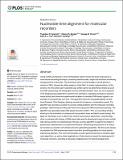Nucleotide-time alignment for molecular recorders
Author(s)
Church, George M.; Tyo, Keith E. J.; Kording, Konrad P.; Cybulski, Thaddeus R; Boyden, Edward
DownloadCybulski-2017-Nucleotide-time alignment for mo.pdf (3.351Mb)
PUBLISHER_CC
Publisher with Creative Commons License
Creative Commons Attribution
Terms of use
Metadata
Show full item recordAbstract
Using a DNA polymerase to record intracellular calcium levels has been proposed as a novel neural recording technique, promising massive-scale, single-cell resolution monitoring of large portions of the brain. This technique relies on local storage of neural activity in strands of DNA, followed by offline analysis of that DNA. In simple implementations of this scheme, the time when each nucleotide was written cannot be determined directly by post-hoc DNA sequencing; the timing data must be estimated instead. Here, we use a Dynamic Time Warping-based algorithm to perform this estimation, exploiting correlations between neural activity and observed experimental variables to translate DNA-based signals to an estimate of neural activity over time. This algorithm improves the parallelizability of traditional Dynamic Time Warping, allowing several-fold increases in computation speed. The algorithm also provides a solution to several critical problems with the molecular recording paradigm: determining recording start times and coping with DNA polymerase pausing. The algorithm can generally locate DNA-based records to within <10% of a recording window, allowing for the estimation of unobserved incorporation times and latent neural tunings. We apply our technique to an in silico motor control neuroscience experiment, using the algorithm to estimate both timings of DNA-based data and the directional tuning of motor cortical cells during a center-out reaching task. We also use this algorithm to explore the impact of polymerase characteristics on system performance, determining the precision of a molecular recorder as a function of its kinetic and error-generating properties. We find useful ranges of properties for DNA polymerase-based recorders, providing guidance for future protein engineering attempts. This work demonstrates a useful general extension to dynamic alignment algorithms, as well as direct applications of that extension toward the development of molecular recorders, providing a necessary stepping stone for future biological work.
Date issued
2017-05Department
Massachusetts Institute of Technology. Department of Biological Engineering; Massachusetts Institute of Technology. Media Laboratory; McGovern Institute for Brain Research at MITJournal
PLoS Computational Biology
Publisher
Public Library of Science
Citation
Cybulski, Thaddeus R.; Boyden, Edward S.; Church, George M.; Tyo, Keith E. J. and Kording, Konrad P. “Nucleotide-Time Alignment for Molecular Recorders.” Edited by Sergei L. Kosakovsky Pond. PLOS Computational Biology 13, no. 5 (May 2017): e1005483 © 2017 Cybulski et al
Version: Final published version
ISSN
1553-7358
1553-734X